Ants
The following gallery of ants will help you determine what type of ant pest problem you might be encountering. All of the pictures show here are from James Castner from the University of Florida.
Picture |
Name |
Description |
 |
Acrobat |
Black, 3 mm long, and hold their abdomens over their heads when disturbed. Usually nest outdoors in dead wood, tree holes and firewood, but can nest in wall voids and insulation. They crawl into buildings around windows and electric cables. Colonies have many queens. |
 |
Argentine |
Dark-brown 2 mm to 3 mm long. Usually nest in exposed or covered soil under logs, debris, firewood and mulch. The ants forage in trails of many workers along sidewalks and foundations, and into buildings, where they forage for food. Colonies have many queens. |
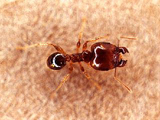 |
Bigheaded |
Yellowish-brown 2 mm to 3 mm long. Workers are either major or minor workers; major workers have very large heads. They nest in the soil under logs, mulch, firewood and next to the foundation of buildings. They often trail along sidewalks and the sides of buildings. They often forage indoors for food and water. Colonies have many queens. |
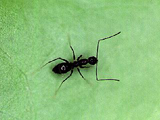 |
Crazy |
Black 3 mm long. It has long legs, and workers move erratically. Colonies are usually found in both moist and dry environments. Outdoors, nests are often in wood, tree holes and in mulch. Indoors, nests are often in wall voids and under stored items. Colonies have many queens. |
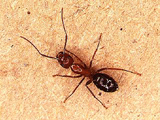 |
Florida Carpenter |
Large ant, 5 mm to 10 mm long, with a yellowish-red thorax and black abdomen. It nests in mulch, logs and in wall voids of houses. It can hollow out wood in order to make its nest, depositing wood pieces nearby. Colonies have only one queen. |
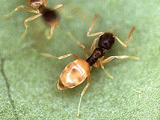 |
Ghost Ant |
1 mm long with a black head and thorax, and clear abdomen and legs. It usually nests outdoors and forages indoors. The ant has a musty odor when squashed. It has a high need for moisture and is often seen in kitchens and bathrooms. Colonies have many queens. |
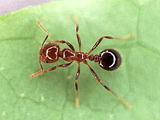 |
Imported Fire |
Reddish-brown and 3 mm to 6 mm long. Fire ants build large mounds in open, sunny areas and can forage indoors. Workers can sting, commonly causing a white pustule to form. Colonies usually have one queen but sometimes have many queens. |
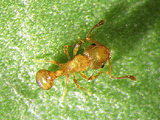 |
Little Fire |
Golden-brown 1 mm to 2 mm long. It nests in soil under logs and debris. It can inflict a painful sting. Colonies have many queens. |
 |
Native Fire |
Reddish-brown to black 3 mm to 6 mm long. It builds irregular, crater-shaped mounds in sunny areas. Workers can sting, but no white pustule forms. They can inflict a painful sting when disturbed. Colonies may have one or more queens. |
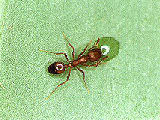 |
Pharaoh |
Rust-colored 2 mm long. Usually nests indoors (in wall voids, refrigerator insulation, books, etc.). Colonies have many queens. |
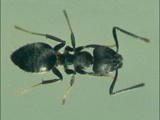 |
White-Footed |
Relatively small (< 3 mm in length), black to brownish ant with yellowish tibia and tarsi (feet) and a one-segmented waist. At first glance, it looks similar to the Argentine ant. However, when the white-footed ant is placed on a sheet of black paper, the tarsi (feet) appear whitish in color. |
Material in this table comes from: P.G. Koehler, Professor; J.L. Castner, Scientific Photographer; Department of Entomology and Nematology, Cooperative Extension Service, Institute of Food and Agricultural Sciences, University of Florida, Gainesville, 32611.
Facts About Ants
Ants are "social" insects. This means they live in large, cooperative family groups called colonies. Within the colony, ants are divided into specific groups, or "castes," that perform different functions. Ants have three castes: workers, queens, and males. The queen's job within the colony is to produce eggs, and the male's job is to simply mate with the queen.
Facts about ants (summarized from a presentation by Alan Bernard, a South Florida Entomologist):
- A single ant does not think, it only reacts to stimuli in its environment
- Ants rely on pheromone trails for foraging
- Only a small portion of the colony (workers) forage for food
- Most ants in the colony work at maintaining the nest, feeding the larvae and queen(s)
- When food is located, workers are recruited to exploit food source
- Larger food sources elicit a larger response
- The colony’s nutritional preferences may vary by season, stage of colony development, or ease of acquisition
- Ants are territorial and will keep less aggressive species out of their feeding areas
- Often there are multiple queens and sub-colonies connected to the main colony
- If sub-colonies are cut off, they can survive and create additional colonies (budding)
- Pest ants are often brought into disturbed sites by human activity (construction, landscaping, commerce, etc.)
- Foraging behavior can be altered by repellent or irritating chemical odors
- Ants will explore an area randomly until a food source is found. They will then return to the colony using straight lines in the environment. They mark this trail with pheromones for other workers to follow
- Most foragers cannot digest large particles of food and must bring these back to the colony to be digested by the larvae and will then feed on a liquid excretion











